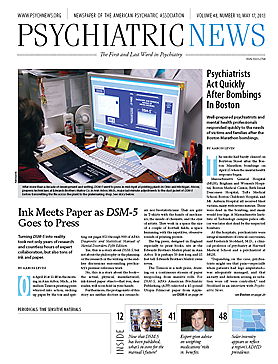For both patients and practitioners, adverse drug effects—whether actual or imagined—are high on the list of reasons for avoiding psychotropic medications.
While the adage may ring true that the cure shouldn’t be worse than the disease, optimal treatments often demand a careful assessment of the balance between risks and benefits. This equation becomes fairly simple when many well-tolerated treatments exist for nonlethal or nondisabling ailments; or conversely, when the morbidity and mortality of a disorder are so obvious as to overshadow concerns about possible treatment complications. For serious disorders, it makes little sense to pick therapies mainly because they have few adverse effects if they are ineffective or to forego more-potent remedies simply because they may have more adverse effects regardless of their manageability.
What factors should practitioners consider when judging whether to use medications that exert large, clinically meaningful effects but also may have formidable adverse effects?
First, survey the degree of morbidity for a given patient, accounting for factors such as symptom severity, chronicity, functional disability, risk for suicide or other dangerous behaviors, prior treatment responsiveness, and quality of life. Higher stakes often warrant higher-risk treatments if they offer prospects for greater efficacy.
Second, differentiate evidence-based options from those lacking established efficacy. Some high-risk/high-benefit treatments are unique or unrivalled, such as monoamine oxidase inhibitors for treatment-resistant depression, clozapine for treatment-resistant schizophrenia, or lithium for euphoric first-episode bipolar mania with a positive family history. Potentially life-saving therapies should not be avoided when their adverse effects can be anticipated and managed.
Herein lies a third consideration: discriminating adverse drug effects that are medically serious (such as agranulocytosis, Stevens Johnson syndrome, or serotonin syndrome) from those that are more annoying than hazardous (such as tremor, sexual dysfunction, dry mouth, or sedation).
Careful monitoring and proactive intervention can strengthen the therapeutic alliance, enhance treatment adherence, and help prevent “nuisance” adverse effects (such as weight gain) from becoming medically dangerous (such as metabolic syndrome).
Risk-benefit appraisals can help practitioners and patients decide together when it is wiser to discontinue an offending agent or to actively manage adverse effects. Remedies to offset adverse effects typically involve “off-label” uses that vary in levels of evidence to support their utility. Examples of common pharmacologic “antidote” strategies include using propranolol or primidone to treat drug-induced tremor; prescribing adjunctive topiramate, zonisamide, metformin, or amantadine to counteract antipsychotic-associated weight gain; using bupropion, buspirone, or sildenafil to mitigate SSRI-induced sexual dysfunction; adding modafinil or armodafinil to antihistaminergic psychotropics to decrease sedation; and favoring less-offensive agents when possible to minimize the worsening of existing problems (for example, using amantadine rather than anticholinergic drugs to treat antipsychotic pseudoparkinsonism in schizophrenia in order to prevent risk of cognitive dulling).
Other basic principles of managing adverse effects include the following:
Streamlining redundant pharmacotherapies or multiple contributors to an adverse effect (e.g., sedation from benzodiazepines plus anticholinergics plus antipsychotics.
Knowing which adverse effects are dose-related (e.g., antipsychotic-associated akathisia; alopecia, nausea, or thrombocytopenia from divalproex; sexual dysfunction from most SSRIs) and which typically are not (e.g., weight gain from olanzapine, orthostatic hypotension from quetiapine, hypothyroidism from lithium).
Differentiating likely iatrogenic effects from the natural course of illness or mere lack of efficacy of a drug against target symptoms (e.g., worsening of depression or suicidality during antidepressant therapy; discriminating akathisia from anxiety or hypomania during antipsychotic treatment), as well as likely “nocebo” effects (i.e., complaints that are nonpharmacodynamic in origin).
Understanding known time courses for particular adverse effects (e.g., serious skin rashes from lamotrigine usually occur from week 2 to week 8 of treatment; drug rashes in general are rare after long-term exposure; clozapine-induced agranulocytosis usually occurs in the first six months of treatment; neuroleptic malignant syndrome usually arises within the first week of exposure to an antipsychotic).
Recognizing high-vulnerability subpopulations (e.g., suicidality from antidepressants is a greater risk in younger than older patients; antidepressant-associated mania is more common in bipolar I than bipolar II disorder).
Clinicians should be familiar with all end-organ effects of prescribed treatments. With a basic working knowledge of primary care medicine, and collaboration with other subspecialists when appropriate, treatments can and should be tailored to individual patients in ways that reflect both safe and effective mental health care. ■

